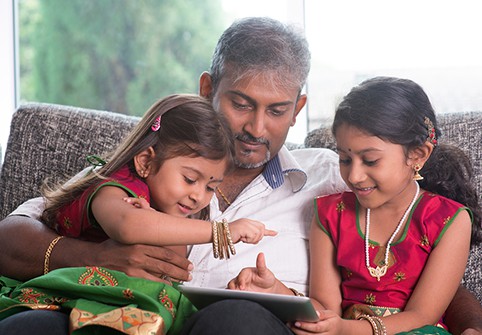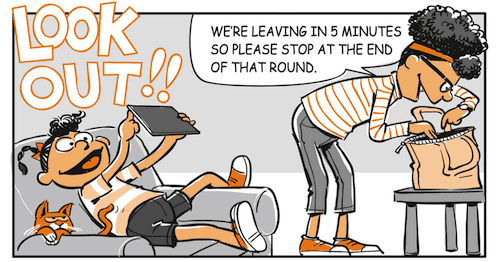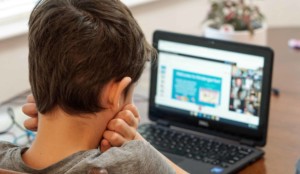How to Turn Screen Time into Family Time

Michelle Miller
I loved playing Where in the World Is Carmen Sandiego? when I was a kid. That was back when games came on disks that were carefully slotted into a desktop computer, and the process of connecting to the Internet gave you enough time to make a sandwich.
Did playing that game contribute to my love of travel? Or, to my future interest in making educational games? It’s hard to say. I do know that following Carmen all over Europe and playing Super Mario with my younger brother were as much a part of my childhood as riding a bike or chasing lightning bugs.
Despite that experience, I’m wary about the role that technology plays for my young daughter. Digital media is more available, more personalized and more integrated into daily life than ever before. Research tells us that it has the power to help kids learn, but also suggests that we should limit when and how often young children are exposed.

At the Joan Ganz Cooney Center, we explore the ways that families use media together, the potential of games for learning and solutions for digital equity. We recently published a free guide called Family Time with Apps with tips for helping busy parents decide how to introduce digital media:
- Talk with your child about which decisions you can make together. The more involved she is in the process, the more likely she will make her own good decisions in the future.
- Use apps and other mobile tools to help support your parenting goals. For example, e-books can make it easier to squeeze in 15 minutes of reading together time every day.
- Research shows that children learn more from all kinds of media when families participate too. So even if it’s just for a few minutes, jump in and play together!
Deciding What to Download
No matter how many amazing things an app or game does, some of the most important learning happens beyond the screen. Here are a few questions to consider before downloading an activity for your child:

1) Does it allow your child to learn and grow? Playing games can place your child in the driver’s seat and offer fun ways to foster her curiosity. The best activities build on your child’s interests in unique ways like walking with dinosaurs, building a skyscraper or playing every instrument in a (virtual) band. Playing games together is also a great chance for your child to be the expert and lead family time, helping her learn how to follow directions, take turns and stay focused.
2) Does it encourage communication? Some activities offer ways to create something together, like a video or a photo album. It’s hard for young children to pay attention during phone calls, but video-conferencing apps can allow them to read a book or share show-and-tell with distant relatives. Even if you don’t play a game together, your child benefits when you talk with her about it afterwards.
3) Does it connect different experiences? Apps, games and other mobile learning tools can be used to help address everyday challenges anytime, anywhere. Playing a game related to a new experience like the first day of school, first plane trip or first haircut can help children prepare for what will happen. Resources like Common Sense Media provide lists of activities organized by themes, such as connecting to outdoor activities and making stressful situations like road trips more fun.
Setting a Predictable Routine
Choosing what digital media to download may be easier while my daughter is very young, but controlling the “when” and the “where” can be a challenge. As much as we try to avoid it, she sees her parents using smartphones and tablets and wants to be part of the action. Just like with sleeping and eating, it’s important to set a predictable routine and be consistent about where, when and for how long your child is allowed to play. Here are a few tips that may help:
- Choose situations or times that you feel are appropriate for using apps (maybe while waiting for an appointment) and limit the rest (for example, during meals).
- Provide a countdown to warn your child before it’s time to stop playing (“We’re leaving in 5 minutes so please stop at the end of that round.”).
- Set a regular time for family play at least once a week.
- Try to avoid using devices close to bedtime.
Of course, there are exceptions. Every now and then we all need that 15 minute break a game provides, and we can’t always play together. (And on a long car ride all bets are off.) As with so many other parenting decisions, it’s easy to feel guilty or worried about our choices. I take heart by watching my daughter, following her cues and trusting my instincts. When she relates something in an app to what we saw at the zoo or jumps up to dance to a song she has created, I see the clear benefits. Really, all it takes is for her to look at me after we’ve played a game together and say, “We did it!” And maybe someday I’ll introduce her to Carmen Sandiego.
This blog is part of our Smart Parents Series in partnership with the Nellie Mae Education Foundation. We would love to have your voice in the Smart Parents conversations. For more information about the project see Parents, Tell Your Story: How You Empower Student Learning as well as other blogs:
- Growth Mindset Parenting
- Is Your Child’s School Student-Centered? A Checklist for School Visits
- Everything is Different Now: Parenting for Powerful Learning

Michelle Miller is Managing Director of the Joan Ganz Cooney Center and mom to a toddler growing up in New York City. Follow her on Twitter @writetommm.







0 Comments
Leave a Comment
Your email address will not be published. All fields are required.